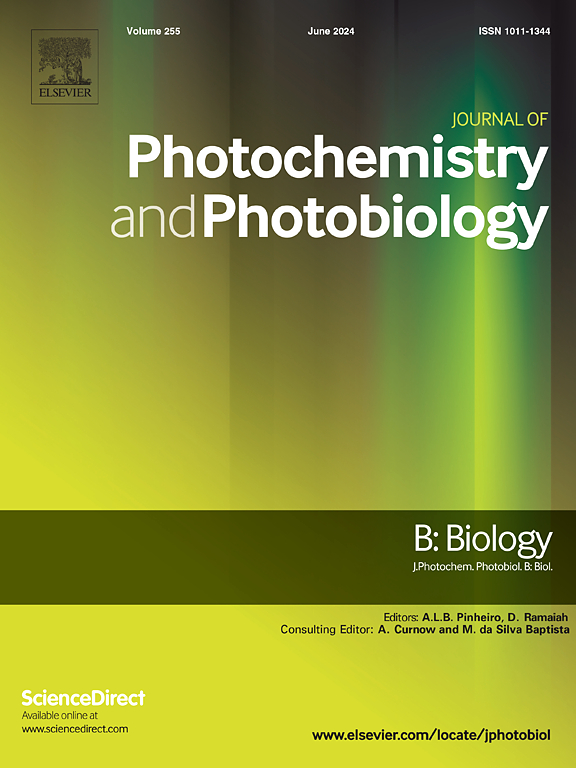光对体外角膜细胞增殖和DNA损伤影响的波长依赖性
IF 3.9
2区 生物学
Q2 BIOCHEMISTRY & MOLECULAR BIOLOGY
Journal of photochemistry and photobiology. B, Biology
Pub Date : 2025-02-01
DOI:10.1016/j.jphotobiol.2025.113118
引用次数: 0
摘要
光的波长依赖性影响的研究主要集中在视网膜上。特别是,观察到可见光谱两端的相反效果,蓝色波长有害,红色波长具有保护作用。然而,很少有关于角膜的研究表明,由于数字设备而增加的人造光暴露与影响角膜的计算机视觉综合征的增加有关。在这项研究中,我们的目标是通过观察细胞死亡和增殖,以及DNA复制和DNA断裂,破译蓝色和红色LED光对角膜内皮细胞原代培养的影响。结果表明,5.35 J/cm2 (455 nm)蓝光照射可抑制DNA复制和细胞增殖,并导致DNA断裂,主要表现为γ - h2ax焦点的形成和DNA断裂。在蓝光的基础上加入0.3 J/cm2 (630 nm)的红光可减轻DNA损伤的形成,并延缓损伤形成和修复的动力学。有趣的是,仅将角膜细胞暴露在红光下会诱导γ - h2ax灶的形成,这种灶不对应于DNA断裂,而是对应于增殖细胞中的DNA复制分叉。我们的研究结果强调了光对角膜的波长依赖效应,并指出γ - h2ax焦点的形成并不总是代表DNA断裂。这强调了光谱对眼睛健康的重要性,这是当今不断变化的光环境中的一个重要问题。本文章由计算机程序翻译,如有差异,请以英文原文为准。

Wavelength-dependency of the impact of light on proliferation and DNA damage of corneal cells in vitro
The wavelength-dependent impact of light has been mainly studied focusing on retina. In particular, an opposite effect of the two ends of the visible spectrum was observed, with blue wavelengths being harmful and red wavelengths being protective. However, few studies on the cornea indicate that the increasing exposition to artificial light due to digital devices is linked to an increase in computer vision syndrome affecting the cornea. In this study, we aim at deciphering the impact of blue and red LED light on a primary culture of corneal endothelial cells, by looking at cell death and proliferation, and at DNA replication and DNA breaks. Our results show that exposure to blue light at 5.35 J/cm2 (455 nm) induces the inhibition of DNA replication and cell proliferation, and the formation of DNA breaks, highlighted by the formation of γH2AX foci and DNA fragmentation. Addition of red light at 0.3 J/cm2 (630 nm) to blue light mitigates the formation of DNA damage and delays the kinetics of formation and repair of the damage. Interestingly, exposure of the corneal cells to red light alone induces the formation of γH2AX foci that do not correspond to DNA breaks, but to DNA replication forks in proliferative cells. Our results highlight the wavelength-dependent effect of light on the cornea, and point out that the formation of γH2AX foci is not always representative of DNA breaks. This emphasizes the importance of light spectrum in eye health, an important issue in today's changing light environment.
求助全文
通过发布文献求助,成功后即可免费获取论文全文。
去求助
来源期刊
CiteScore
12.10
自引率
1.90%
发文量
161
审稿时长
37 days
期刊介绍:
The Journal of Photochemistry and Photobiology B: Biology provides a forum for the publication of papers relating to the various aspects of photobiology, as well as a means for communication in this multidisciplinary field.
The scope includes:
- Bioluminescence
- Chronobiology
- DNA repair
- Environmental photobiology
- Nanotechnology in photobiology
- Photocarcinogenesis
- Photochemistry of biomolecules
- Photodynamic therapy
- Photomedicine
- Photomorphogenesis
- Photomovement
- Photoreception
- Photosensitization
- Photosynthesis
- Phototechnology
- Spectroscopy of biological systems
- UV and visible radiation effects and vision.

 求助内容:
求助内容: 应助结果提醒方式:
应助结果提醒方式:


